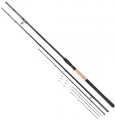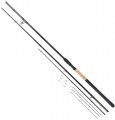Max. casting
The maximum weight of the entire rig (including bait, weights, hooks, etc.) that the rod can handle. This parameter is not recommended to be exceeded: the structure will be subjected to off-design loads and wear out a lot, to the point that the rod can simply break during a normal cast. In addition, the off-design weight of the casting significantly reduces the range and accuracy of the cast, which is critical, in particular, in spinning and match fishing (see "Rod type").
Tips
The uppermost rod storage, which is removable in many rods, especially feeder rods. First of all, the tip acts as a bite signaling device. There are several types that differ among themselves in the degree of flexibility: soft, medium hardness and hard. So, soft models are the most sensitive and allow you to detect the smallest fluctuations of the signaling device, which makes them excellent for catching “neat and careful” fish species. Hard tips are well suited for windy conditions, as they do not confuse the bite with the usual wind.
Working length
The length of the rod in the unfolded (working) position. For different types of fishing, different lengths are considered optimal; see "Rod Type" for more on this. If the type of rod you need has numerous length variations, when choosing, you should take into account the conditions in which you have to fish. On the one hand, longer models usually have a greater casting distance (this is especially true for float fishing); on the other hand, for limited conditions (for example, with dense vegetation on the shore or when fishing from a boat), it may make sense to take a shorter rod.
Folded length
The length of the rod when folded. This parameter primarily affects the convenience of transportation: the shorter the folded rod, the easier it is to carry / transport.

